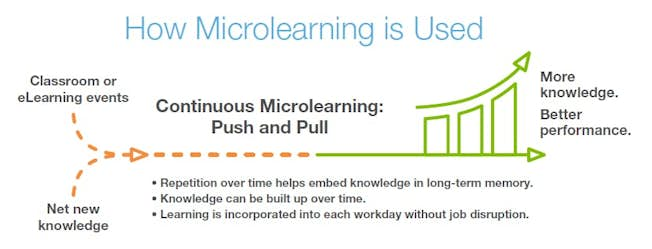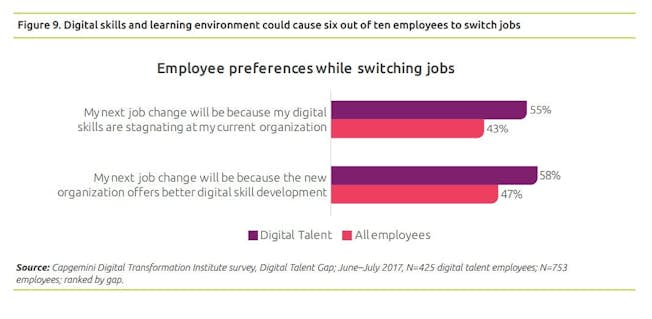May 13, 2019
6 Ways Your Business Can Quickly Upskill Its Workforce
Technological advancements are keeping the modern workforce on its toes. The World Economic Forum projects that robotics, autonomous transport, artificial intelligence, and biotechnology will create the biggest changes in industries around the world. Businesses that want to thrive in these changing conditions will need a workforce with new skills, especially digital skills.
You need to upskill your workforce quickly so that they can take advantage of new digital tools before your competition does. Those whose employees can shift with new technology will have a more agile business and will benefit from the projected boosts to productivity that technological change is bringing. Also, there’s research to suggest that if you don’t offer to upskill opportunities to your most digitally savvy employees, they will leave.
Thankfully, you have many options to change your workforce and meet the demands of today. There are at least six options, each requiring different costs and levels of investment in your workforce. Of course, there is no one-size-fits-all option. Each organization faces unique challenges, so any one of these solutions, or a mixture of many, may be best for you.
1. Continuous Professional Development
More than just training new skills, professional development gives your workforce the chance to earn certifications throughout their career with you. Why focus on gaining professional qualifications for your workforce instead of more typical training programs?
Having your staff complete widely recognized training programs ensures they have the skills as newcomers to their field, and that they have the skills to beat out your competition. Professional, focused certifications offer a depth of education that can’t be replicated by many other forms of learning.
Some mistakenly believe that because you’re offering a certification it must be a generalized education, meant to give anyone a wide range of digital skills, some of which may not apply to your specific workplace. Instead, we can create a very customized professional development plan for your employees to address the specific skills they will need to thrive in your workplace.
For example, we helped IBM create a specialized certification process for its sales employees. Instead of a generalized program, the certification process taught IBM’s workforce how to overcome the specific challenges IBM was facing. From this program, IBM’s digital sales force saw a 7% win rate increase and a 37% reduction in days to close.
2. Microlearning

Microlearning is even more targeted than continuous professional development. It involves giving your employees small bursts of education about very specific skills. This way, you can target top areas of concern in your workforce, without investing too many resources or having critical staff take too much time away from their duties.
This is also a flexible form of learning. You may have a suite of microlearning courses and choose which ones are important for any specific role within your company.
By having employees only learn what is crucial for their tasks, you save time. Also, microlearning allows you to give employees access to training precisely when they need it. As employees gain new responsibilities, they can access new microlearning modules.
3. Retraining
When your company invests in new technology or changes the way it does business, you’ll find that you need employees with new skills. When you try to recruit them, you’ll find that there aren’t enough technically talented people to go around. In fact, a CareerBuilder survey has found that 60% of companies cannot fill their open positions with qualified candidates.
You currently have talented people in your organization, who haven’t been exposed to the training they need to meet your company’s new skill gap. Investing in retraining some of these employees will help you get technical talent for less. After all, they are already integrated into your workplace culture and have invaluable knowledge from their current position.
The benefits of retraining low-skill employees for new positions within your organization are clear, from avoiding the tight competition to collect technical talent, to maintaining loyalty to your organization. However, you can’t afford to only focus on your least technically talented employees.
4. Update Your Experts

Some of the employees in your workforce are already digitally-savvy and actively pursuing new training and in-demand skills on their own. These employees are very valuable, but research demonstrates that you may lose them if you don’t give them the opportunity to improve their skills further.
According to a report from Capgemini and LinkedIn, roughly half (55%) of digitally talented employees admit they will leave their current employer if they feel that staying is limiting their skill development. These employees know that maintaining their digital savvy makes them a valuable asset, and to keep them with you, you need to offer them skill development.
The same report found that when digitally talented employees are looking for a new employer, about half (47%) are swayed by employers who offer digital skill development.
While you may be focusing on updating employees who are behind, you need to make sure you’re updating your most expert staff as well. This boosts their loyalty and sharpens their skills – all to your benefit. Updating your experts can also allow you to offer peer support programs.
5. Peer Support Programs
Your plans to upskill your workforce shouldn’t exclude internal training opportunities. If you have digitally savvy employees in your organization, make the most of their ability through a peer support program. Not only can your employees swap skills, but they are already familiar with your workplace and can make the training highly relevant for your business.
Peer support programs are smart for another reason. Research demonstrates that 75% of organizations are only investing $500 per employee for training and upskilling. If you’re facing budgetary pressures, a peer support program may be right for you, at least at first. Using your existing workforce to train your people is less resource intensive than investing in outside training.
Catching your least experience staff up to the competence level of your other staff can then allow you to upskill a larger portion of your workforce even further, for a lower overall cost.
6. Offer New Career Paths

Technological changes may make some of the career paths in your organization dry up, but it should also open up new ones. Investing in offering those paths early on can help you retain staff instead of letting them go as their career path ends. Jumping into technological change can make the best opportunities for your business and your workforce.
Consider the example of AT&T, which has been actively fostering and supporting new career paths for their employees since 2013, according to Forbes. In a few months, the company retrained enough staff to fill half of its tech management jobs. The company found that retraining their staff lowered their product-development life-cycle by 40% and accelerated time to revenue by 32%
Final thoughts
Your business can benefit in the same way if you take the time to upskill your workforce and make each employee more competitive in their role—even if it’s a role they never imagined they could fill before.
The question remains: which of these upskill methods, or a combination of them, is right for your organization?
- Categories:
- Articles
- Digital Management and Leadership
Upgrade to Power Membership to continue
your access to thousands of articles, toolkits, podcasts, lessons and much much more.
Become a Power Member- Login
- View Courses
- - - -
- Courses
- Resources
- - - -
- My Account
- Change Password
- Logout




